NRSG367 Assessment 2: Reflection on Nursing Practice Standards
VerifiedAdded on 2022/10/09
|9
|2029
|170
Report
AI Summary
This report is a reflection on two key standards of practice for registered nurses, as outlined by the Nursing and Midwifery Board of Australia (NMBA). The author, a nursing student, utilizes the 5R's reflection model (Reporting, Responding, Relating, Reasoning, and Reconstructing) to analyze experiences from clinical placements in medical, surgical, and mental health settings. The first standard, "Think critically and analyze nursing practice," is examined through a scenario involving a mentally agitated patient, highlighting the importance of critical thinking, patient assessment, and effective communication. The second standard, "Providing safe, appropriate and objective quality nursing," is illustrated through a case of a post-surgery patient, emphasizing the need for teamwork, adherence to protocols, and quality patient care. Each section is supported by academic references, demonstrating the student's understanding of nursing principles and their ability to apply them in practice. The report concludes with a summary of the key takeaways and the student's growth in understanding the importance of nursing standards in delivering safe and effective patient care.
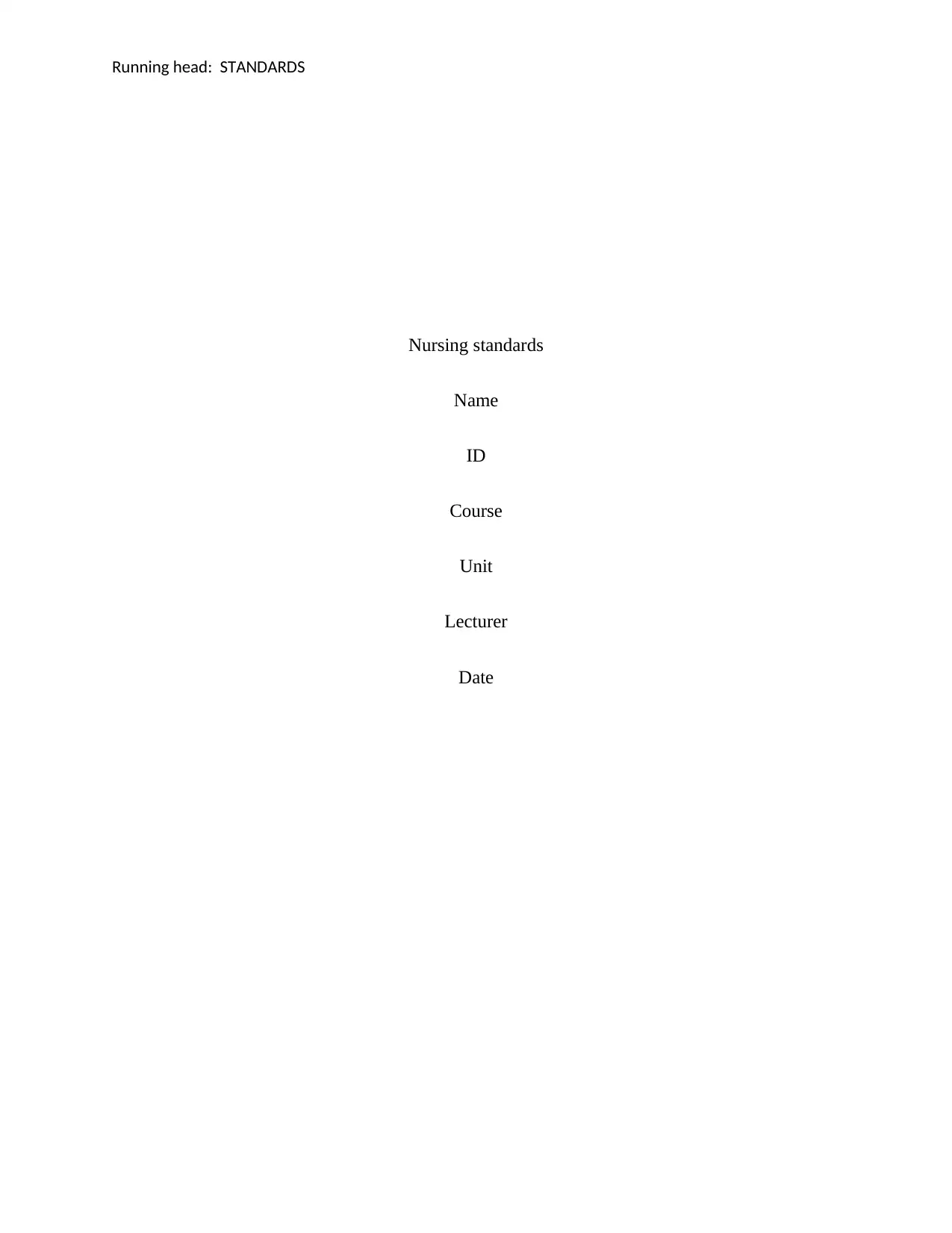
Running head: STANDARDS
Nursing standards
Name
ID
Course
Unit
Lecturer
Date
Nursing standards
Name
ID
Course
Unit
Lecturer
Date
Paraphrase This Document
Need a fresh take? Get an instant paraphrase of this document with our AI Paraphraser
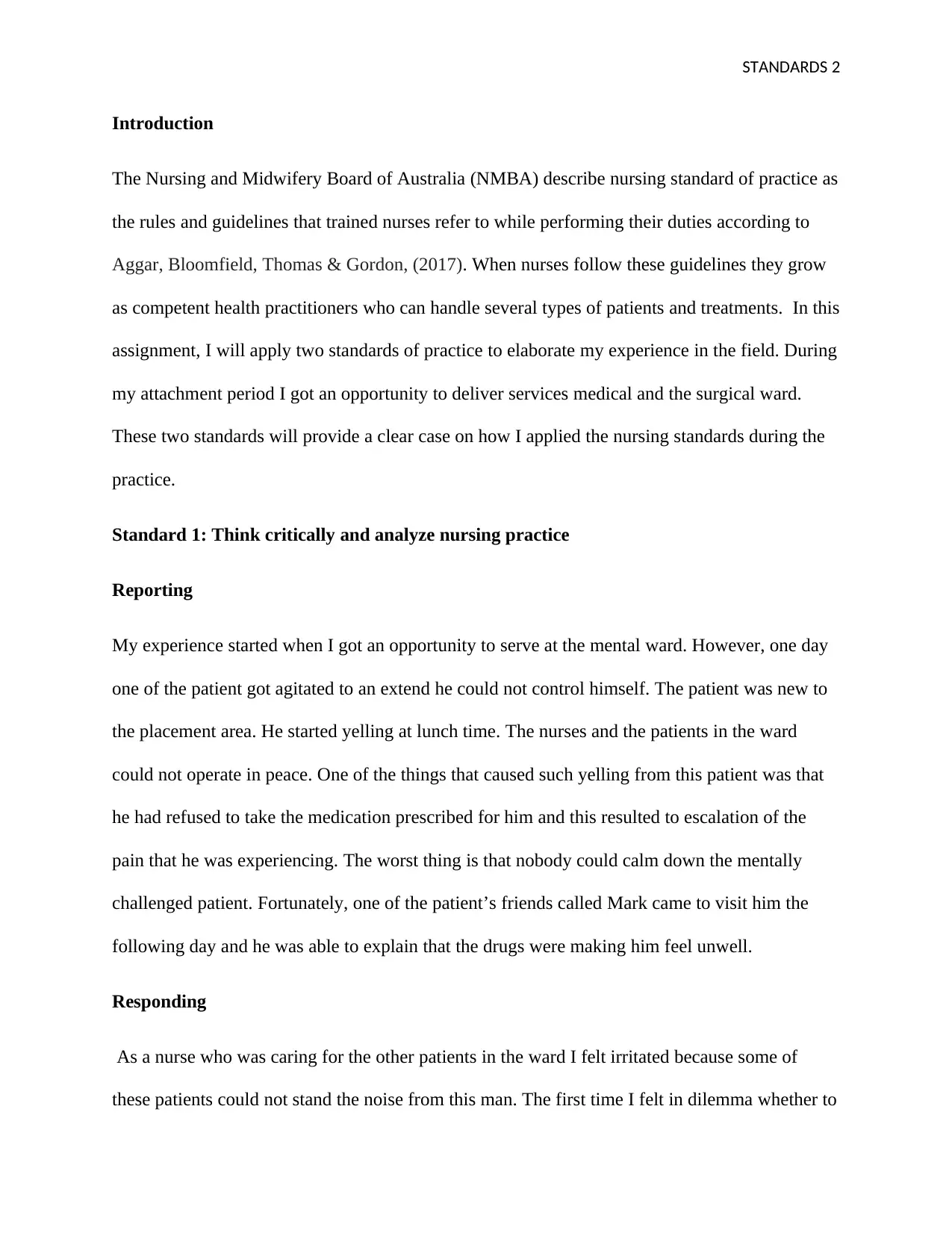
STANDARDS 2
Introduction
The Nursing and Midwifery Board of Australia (NMBA) describe nursing standard of practice as
the rules and guidelines that trained nurses refer to while performing their duties according to
Aggar, Bloomfield, Thomas & Gordon, (2017). When nurses follow these guidelines they grow
as competent health practitioners who can handle several types of patients and treatments. In this
assignment, I will apply two standards of practice to elaborate my experience in the field. During
my attachment period I got an opportunity to deliver services medical and the surgical ward.
These two standards will provide a clear case on how I applied the nursing standards during the
practice.
Standard 1: Think critically and analyze nursing practice
Reporting
My experience started when I got an opportunity to serve at the mental ward. However, one day
one of the patient got agitated to an extend he could not control himself. The patient was new to
the placement area. He started yelling at lunch time. The nurses and the patients in the ward
could not operate in peace. One of the things that caused such yelling from this patient was that
he had refused to take the medication prescribed for him and this resulted to escalation of the
pain that he was experiencing. The worst thing is that nobody could calm down the mentally
challenged patient. Fortunately, one of the patient’s friends called Mark came to visit him the
following day and he was able to explain that the drugs were making him feel unwell.
Responding
As a nurse who was caring for the other patients in the ward I felt irritated because some of
these patients could not stand the noise from this man. The first time I felt in dilemma whether to
Introduction
The Nursing and Midwifery Board of Australia (NMBA) describe nursing standard of practice as
the rules and guidelines that trained nurses refer to while performing their duties according to
Aggar, Bloomfield, Thomas & Gordon, (2017). When nurses follow these guidelines they grow
as competent health practitioners who can handle several types of patients and treatments. In this
assignment, I will apply two standards of practice to elaborate my experience in the field. During
my attachment period I got an opportunity to deliver services medical and the surgical ward.
These two standards will provide a clear case on how I applied the nursing standards during the
practice.
Standard 1: Think critically and analyze nursing practice
Reporting
My experience started when I got an opportunity to serve at the mental ward. However, one day
one of the patient got agitated to an extend he could not control himself. The patient was new to
the placement area. He started yelling at lunch time. The nurses and the patients in the ward
could not operate in peace. One of the things that caused such yelling from this patient was that
he had refused to take the medication prescribed for him and this resulted to escalation of the
pain that he was experiencing. The worst thing is that nobody could calm down the mentally
challenged patient. Fortunately, one of the patient’s friends called Mark came to visit him the
following day and he was able to explain that the drugs were making him feel unwell.
Responding
As a nurse who was caring for the other patients in the ward I felt irritated because some of
these patients could not stand the noise from this man. The first time I felt in dilemma whether to
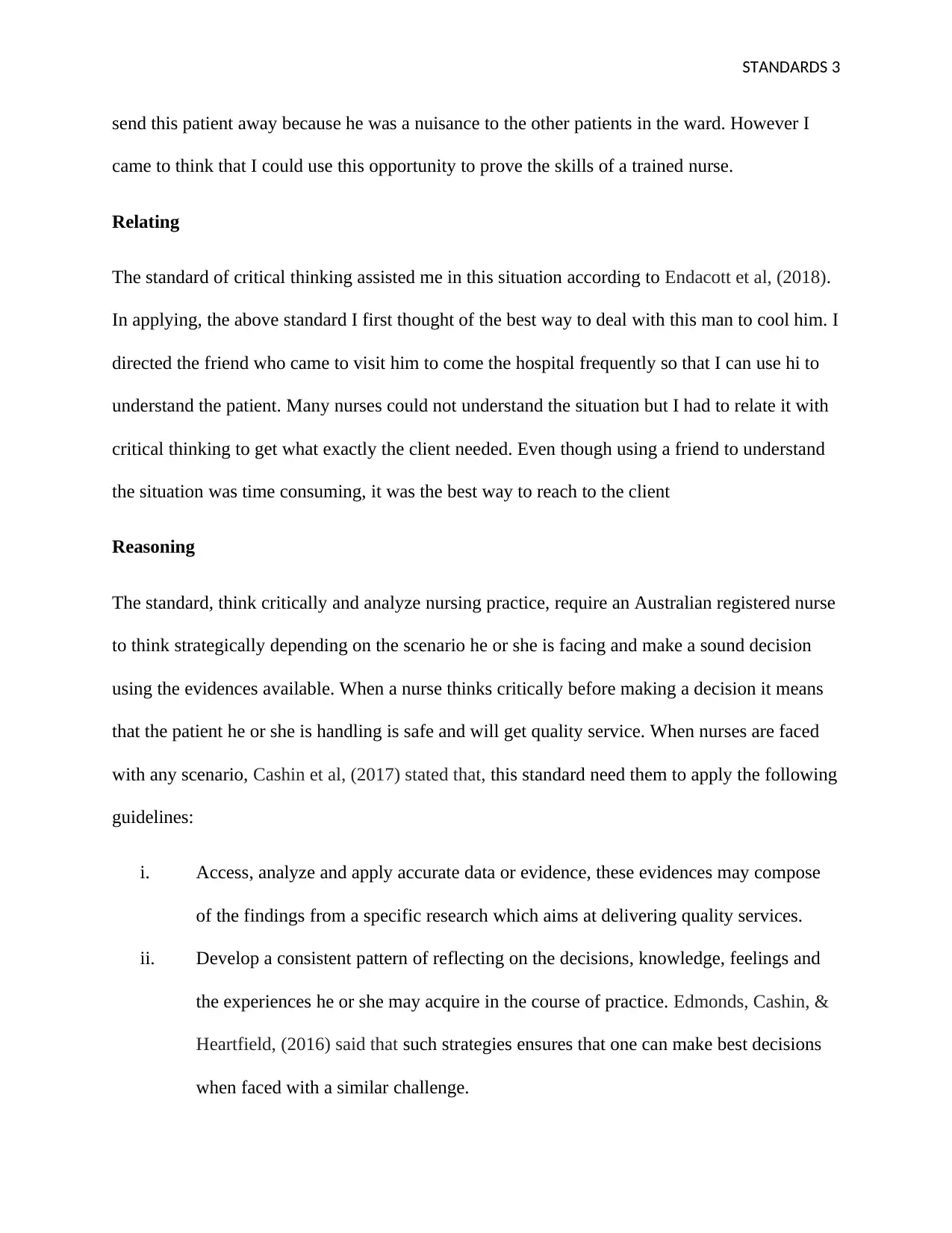
STANDARDS 3
send this patient away because he was a nuisance to the other patients in the ward. However I
came to think that I could use this opportunity to prove the skills of a trained nurse.
Relating
The standard of critical thinking assisted me in this situation according to Endacott et al, (2018).
In applying, the above standard I first thought of the best way to deal with this man to cool him. I
directed the friend who came to visit him to come the hospital frequently so that I can use hi to
understand the patient. Many nurses could not understand the situation but I had to relate it with
critical thinking to get what exactly the client needed. Even though using a friend to understand
the situation was time consuming, it was the best way to reach to the client
Reasoning
The standard, think critically and analyze nursing practice, require an Australian registered nurse
to think strategically depending on the scenario he or she is facing and make a sound decision
using the evidences available. When a nurse thinks critically before making a decision it means
that the patient he or she is handling is safe and will get quality service. When nurses are faced
with any scenario, Cashin et al, (2017) stated that, this standard need them to apply the following
guidelines:
i. Access, analyze and apply accurate data or evidence, these evidences may compose
of the findings from a specific research which aims at delivering quality services.
ii. Develop a consistent pattern of reflecting on the decisions, knowledge, feelings and
the experiences he or she may acquire in the course of practice. Edmonds, Cashin, &
Heartfield, (2016) said that such strategies ensures that one can make best decisions
when faced with a similar challenge.
send this patient away because he was a nuisance to the other patients in the ward. However I
came to think that I could use this opportunity to prove the skills of a trained nurse.
Relating
The standard of critical thinking assisted me in this situation according to Endacott et al, (2018).
In applying, the above standard I first thought of the best way to deal with this man to cool him. I
directed the friend who came to visit him to come the hospital frequently so that I can use hi to
understand the patient. Many nurses could not understand the situation but I had to relate it with
critical thinking to get what exactly the client needed. Even though using a friend to understand
the situation was time consuming, it was the best way to reach to the client
Reasoning
The standard, think critically and analyze nursing practice, require an Australian registered nurse
to think strategically depending on the scenario he or she is facing and make a sound decision
using the evidences available. When a nurse thinks critically before making a decision it means
that the patient he or she is handling is safe and will get quality service. When nurses are faced
with any scenario, Cashin et al, (2017) stated that, this standard need them to apply the following
guidelines:
i. Access, analyze and apply accurate data or evidence, these evidences may compose
of the findings from a specific research which aims at delivering quality services.
ii. Develop a consistent pattern of reflecting on the decisions, knowledge, feelings and
the experiences he or she may acquire in the course of practice. Edmonds, Cashin, &
Heartfield, (2016) said that such strategies ensures that one can make best decisions
when faced with a similar challenge.
⊘ This is a preview!⊘
Do you want full access?
Subscribe today to unlock all pages.

Trusted by 1+ million students worldwide
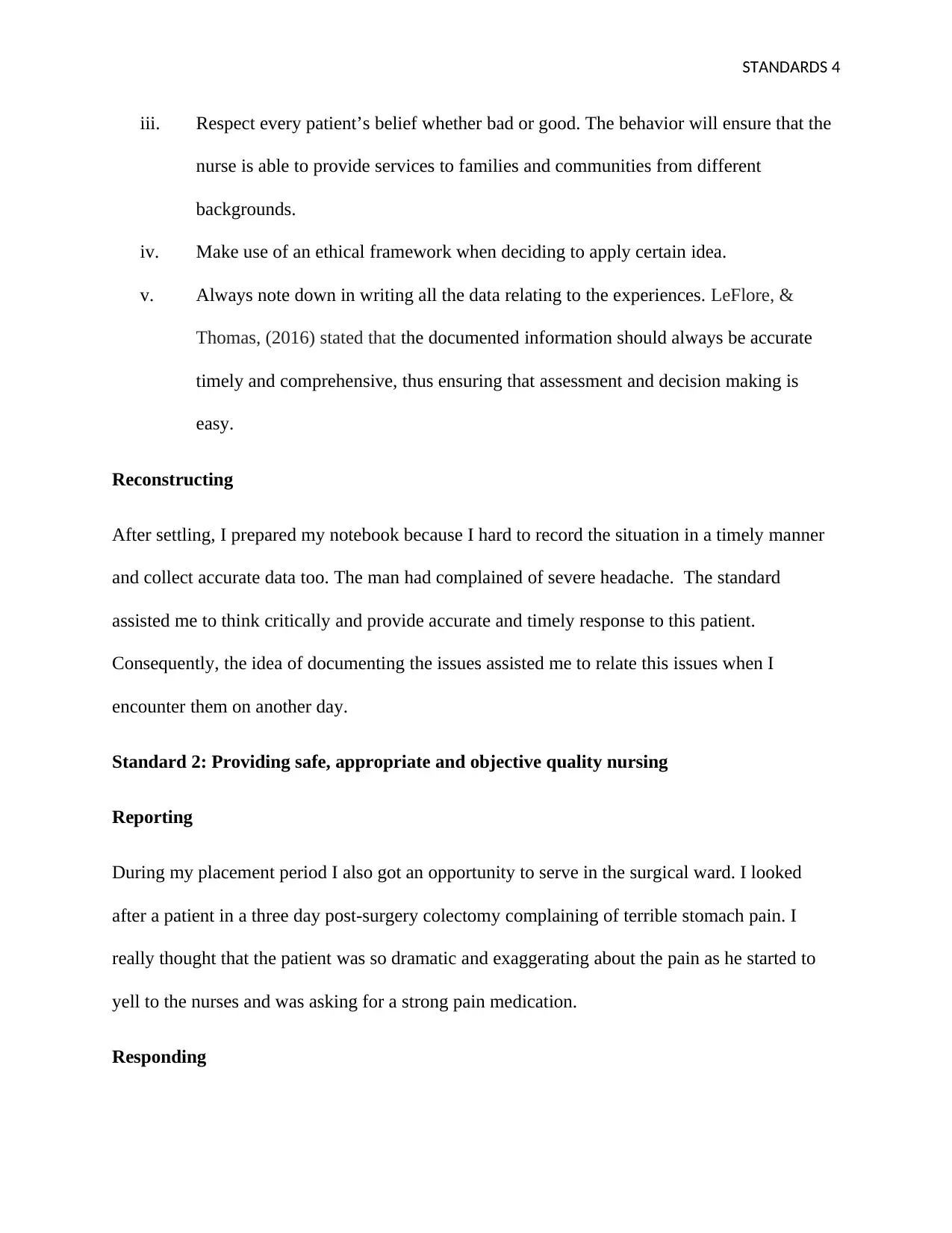
STANDARDS 4
iii. Respect every patient’s belief whether bad or good. The behavior will ensure that the
nurse is able to provide services to families and communities from different
backgrounds.
iv. Make use of an ethical framework when deciding to apply certain idea.
v. Always note down in writing all the data relating to the experiences. LeFlore, &
Thomas, (2016) stated that the documented information should always be accurate
timely and comprehensive, thus ensuring that assessment and decision making is
easy.
Reconstructing
After settling, I prepared my notebook because I hard to record the situation in a timely manner
and collect accurate data too. The man had complained of severe headache. The standard
assisted me to think critically and provide accurate and timely response to this patient.
Consequently, the idea of documenting the issues assisted me to relate this issues when I
encounter them on another day.
Standard 2: Providing safe, appropriate and objective quality nursing
Reporting
During my placement period I also got an opportunity to serve in the surgical ward. I looked
after a patient in a three day post-surgery colectomy complaining of terrible stomach pain. I
really thought that the patient was so dramatic and exaggerating about the pain as he started to
yell to the nurses and was asking for a strong pain medication.
Responding
iii. Respect every patient’s belief whether bad or good. The behavior will ensure that the
nurse is able to provide services to families and communities from different
backgrounds.
iv. Make use of an ethical framework when deciding to apply certain idea.
v. Always note down in writing all the data relating to the experiences. LeFlore, &
Thomas, (2016) stated that the documented information should always be accurate
timely and comprehensive, thus ensuring that assessment and decision making is
easy.
Reconstructing
After settling, I prepared my notebook because I hard to record the situation in a timely manner
and collect accurate data too. The man had complained of severe headache. The standard
assisted me to think critically and provide accurate and timely response to this patient.
Consequently, the idea of documenting the issues assisted me to relate this issues when I
encounter them on another day.
Standard 2: Providing safe, appropriate and objective quality nursing
Reporting
During my placement period I also got an opportunity to serve in the surgical ward. I looked
after a patient in a three day post-surgery colectomy complaining of terrible stomach pain. I
really thought that the patient was so dramatic and exaggerating about the pain as he started to
yell to the nurses and was asking for a strong pain medication.
Responding
Paraphrase This Document
Need a fresh take? Get an instant paraphrase of this document with our AI Paraphraser
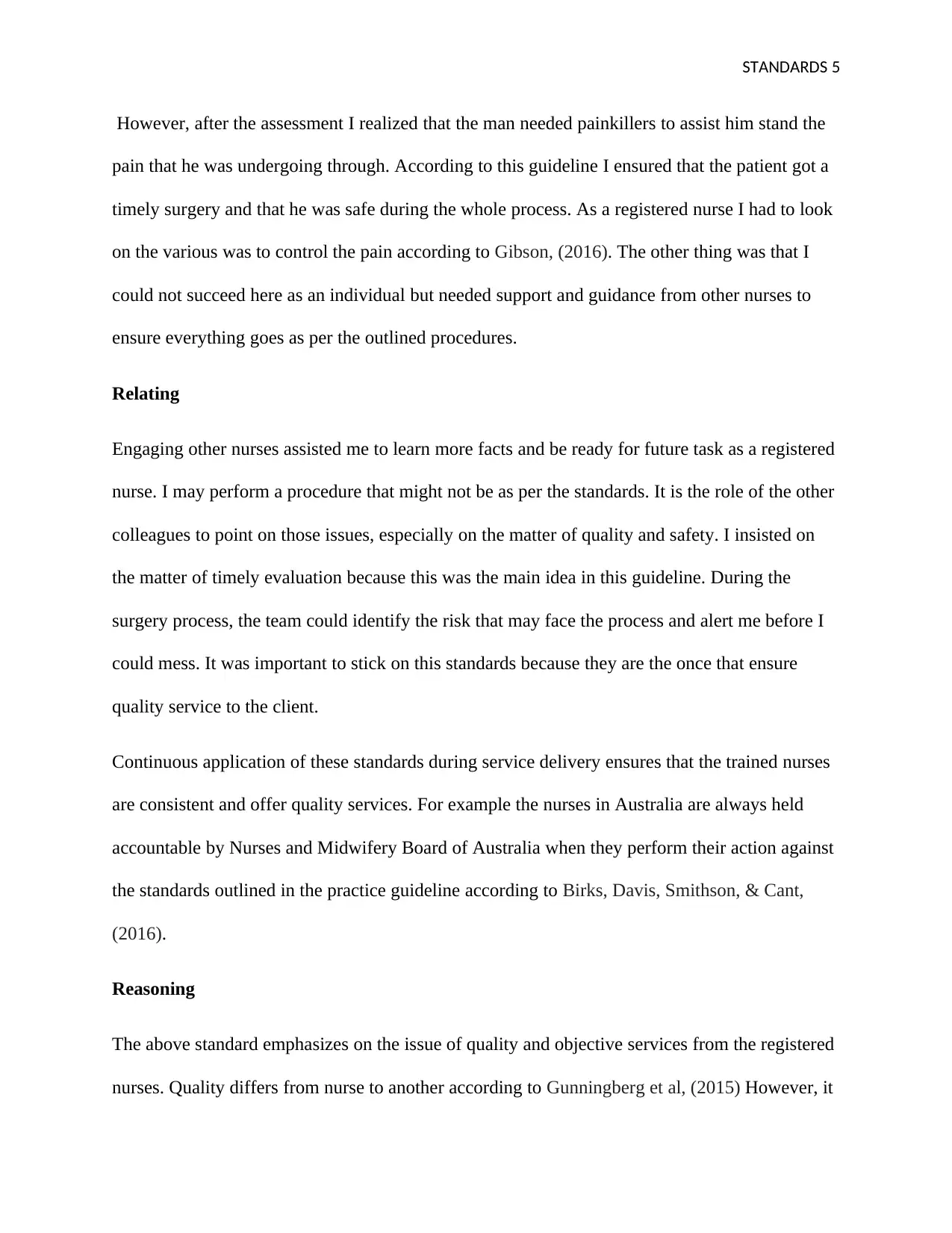
STANDARDS 5
However, after the assessment I realized that the man needed painkillers to assist him stand the
pain that he was undergoing through. According to this guideline I ensured that the patient got a
timely surgery and that he was safe during the whole process. As a registered nurse I had to look
on the various was to control the pain according to Gibson, (2016). The other thing was that I
could not succeed here as an individual but needed support and guidance from other nurses to
ensure everything goes as per the outlined procedures.
Relating
Engaging other nurses assisted me to learn more facts and be ready for future task as a registered
nurse. I may perform a procedure that might not be as per the standards. It is the role of the other
colleagues to point on those issues, especially on the matter of quality and safety. I insisted on
the matter of timely evaluation because this was the main idea in this guideline. During the
surgery process, the team could identify the risk that may face the process and alert me before I
could mess. It was important to stick on this standards because they are the once that ensure
quality service to the client.
Continuous application of these standards during service delivery ensures that the trained nurses
are consistent and offer quality services. For example the nurses in Australia are always held
accountable by Nurses and Midwifery Board of Australia when they perform their action against
the standards outlined in the practice guideline according to Birks, Davis, Smithson, & Cant,
(2016).
Reasoning
The above standard emphasizes on the issue of quality and objective services from the registered
nurses. Quality differs from nurse to another according to Gunningberg et al, (2015) However, it
However, after the assessment I realized that the man needed painkillers to assist him stand the
pain that he was undergoing through. According to this guideline I ensured that the patient got a
timely surgery and that he was safe during the whole process. As a registered nurse I had to look
on the various was to control the pain according to Gibson, (2016). The other thing was that I
could not succeed here as an individual but needed support and guidance from other nurses to
ensure everything goes as per the outlined procedures.
Relating
Engaging other nurses assisted me to learn more facts and be ready for future task as a registered
nurse. I may perform a procedure that might not be as per the standards. It is the role of the other
colleagues to point on those issues, especially on the matter of quality and safety. I insisted on
the matter of timely evaluation because this was the main idea in this guideline. During the
surgery process, the team could identify the risk that may face the process and alert me before I
could mess. It was important to stick on this standards because they are the once that ensure
quality service to the client.
Continuous application of these standards during service delivery ensures that the trained nurses
are consistent and offer quality services. For example the nurses in Australia are always held
accountable by Nurses and Midwifery Board of Australia when they perform their action against
the standards outlined in the practice guideline according to Birks, Davis, Smithson, & Cant,
(2016).
Reasoning
The above standard emphasizes on the issue of quality and objective services from the registered
nurses. Quality differs from nurse to another according to Gunningberg et al, (2015) However, it
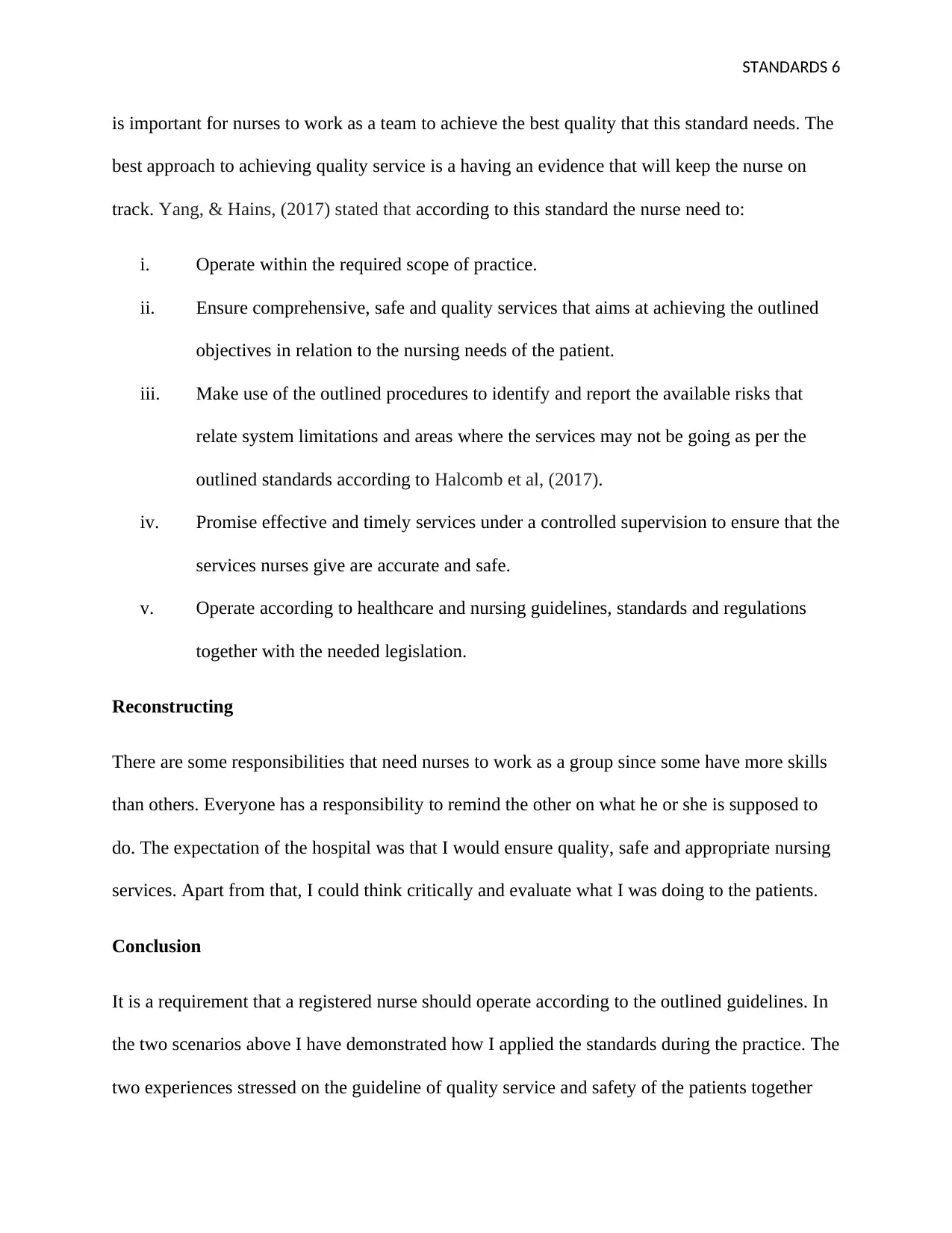
STANDARDS 6
is important for nurses to work as a team to achieve the best quality that this standard needs. The
best approach to achieving quality service is a having an evidence that will keep the nurse on
track. Yang, & Hains, (2017) stated that according to this standard the nurse need to:
i. Operate within the required scope of practice.
ii. Ensure comprehensive, safe and quality services that aims at achieving the outlined
objectives in relation to the nursing needs of the patient.
iii. Make use of the outlined procedures to identify and report the available risks that
relate system limitations and areas where the services may not be going as per the
outlined standards according to Halcomb et al, (2017).
iv. Promise effective and timely services under a controlled supervision to ensure that the
services nurses give are accurate and safe.
v. Operate according to healthcare and nursing guidelines, standards and regulations
together with the needed legislation.
Reconstructing
There are some responsibilities that need nurses to work as a group since some have more skills
than others. Everyone has a responsibility to remind the other on what he or she is supposed to
do. The expectation of the hospital was that I would ensure quality, safe and appropriate nursing
services. Apart from that, I could think critically and evaluate what I was doing to the patients.
Conclusion
It is a requirement that a registered nurse should operate according to the outlined guidelines. In
the two scenarios above I have demonstrated how I applied the standards during the practice. The
two experiences stressed on the guideline of quality service and safety of the patients together
is important for nurses to work as a team to achieve the best quality that this standard needs. The
best approach to achieving quality service is a having an evidence that will keep the nurse on
track. Yang, & Hains, (2017) stated that according to this standard the nurse need to:
i. Operate within the required scope of practice.
ii. Ensure comprehensive, safe and quality services that aims at achieving the outlined
objectives in relation to the nursing needs of the patient.
iii. Make use of the outlined procedures to identify and report the available risks that
relate system limitations and areas where the services may not be going as per the
outlined standards according to Halcomb et al, (2017).
iv. Promise effective and timely services under a controlled supervision to ensure that the
services nurses give are accurate and safe.
v. Operate according to healthcare and nursing guidelines, standards and regulations
together with the needed legislation.
Reconstructing
There are some responsibilities that need nurses to work as a group since some have more skills
than others. Everyone has a responsibility to remind the other on what he or she is supposed to
do. The expectation of the hospital was that I would ensure quality, safe and appropriate nursing
services. Apart from that, I could think critically and evaluate what I was doing to the patients.
Conclusion
It is a requirement that a registered nurse should operate according to the outlined guidelines. In
the two scenarios above I have demonstrated how I applied the standards during the practice. The
two experiences stressed on the guideline of quality service and safety of the patients together
⊘ This is a preview!⊘
Do you want full access?
Subscribe today to unlock all pages.

Trusted by 1+ million students worldwide
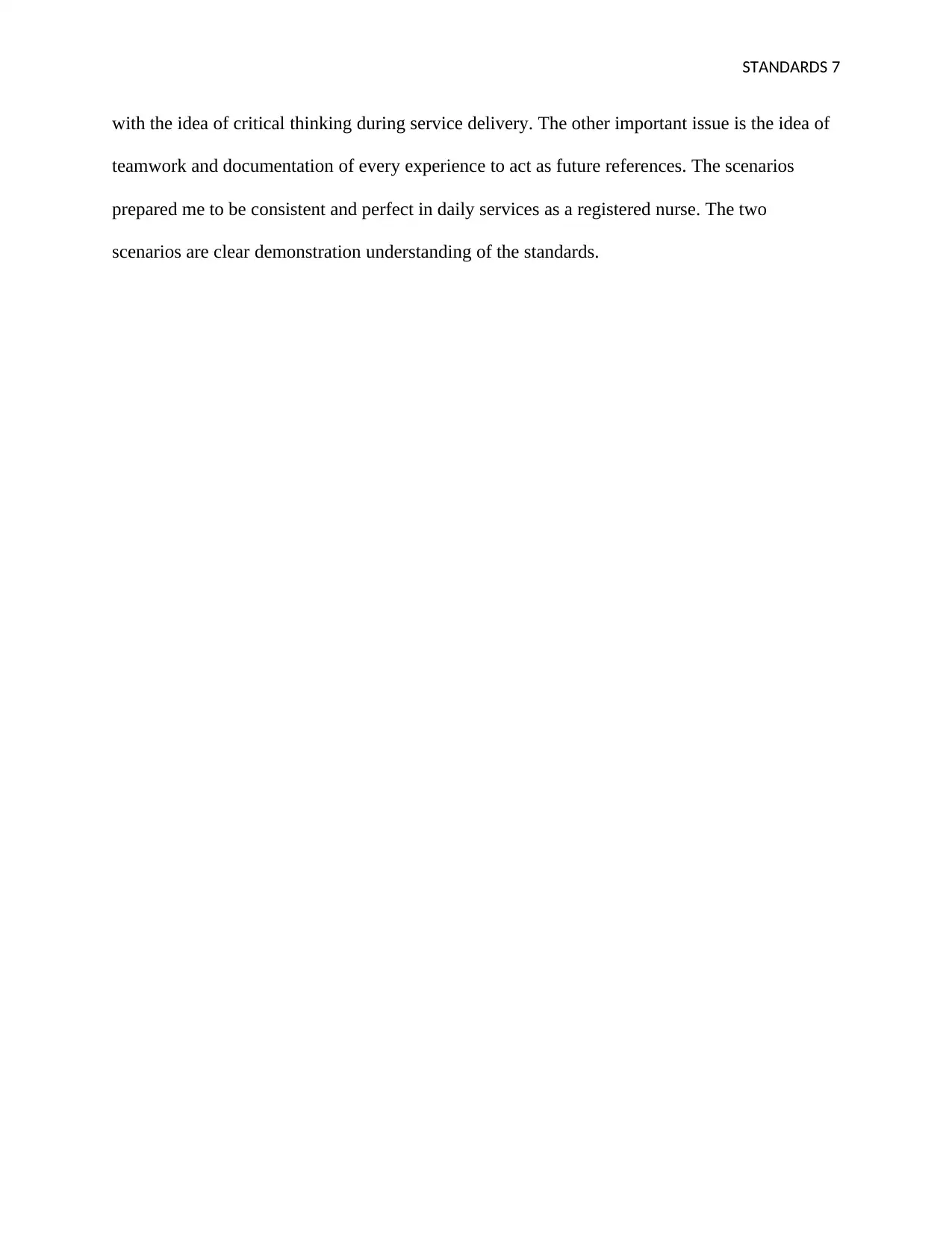
STANDARDS 7
with the idea of critical thinking during service delivery. The other important issue is the idea of
teamwork and documentation of every experience to act as future references. The scenarios
prepared me to be consistent and perfect in daily services as a registered nurse. The two
scenarios are clear demonstration understanding of the standards.
with the idea of critical thinking during service delivery. The other important issue is the idea of
teamwork and documentation of every experience to act as future references. The scenarios
prepared me to be consistent and perfect in daily services as a registered nurse. The two
scenarios are clear demonstration understanding of the standards.
Paraphrase This Document
Need a fresh take? Get an instant paraphrase of this document with our AI Paraphraser
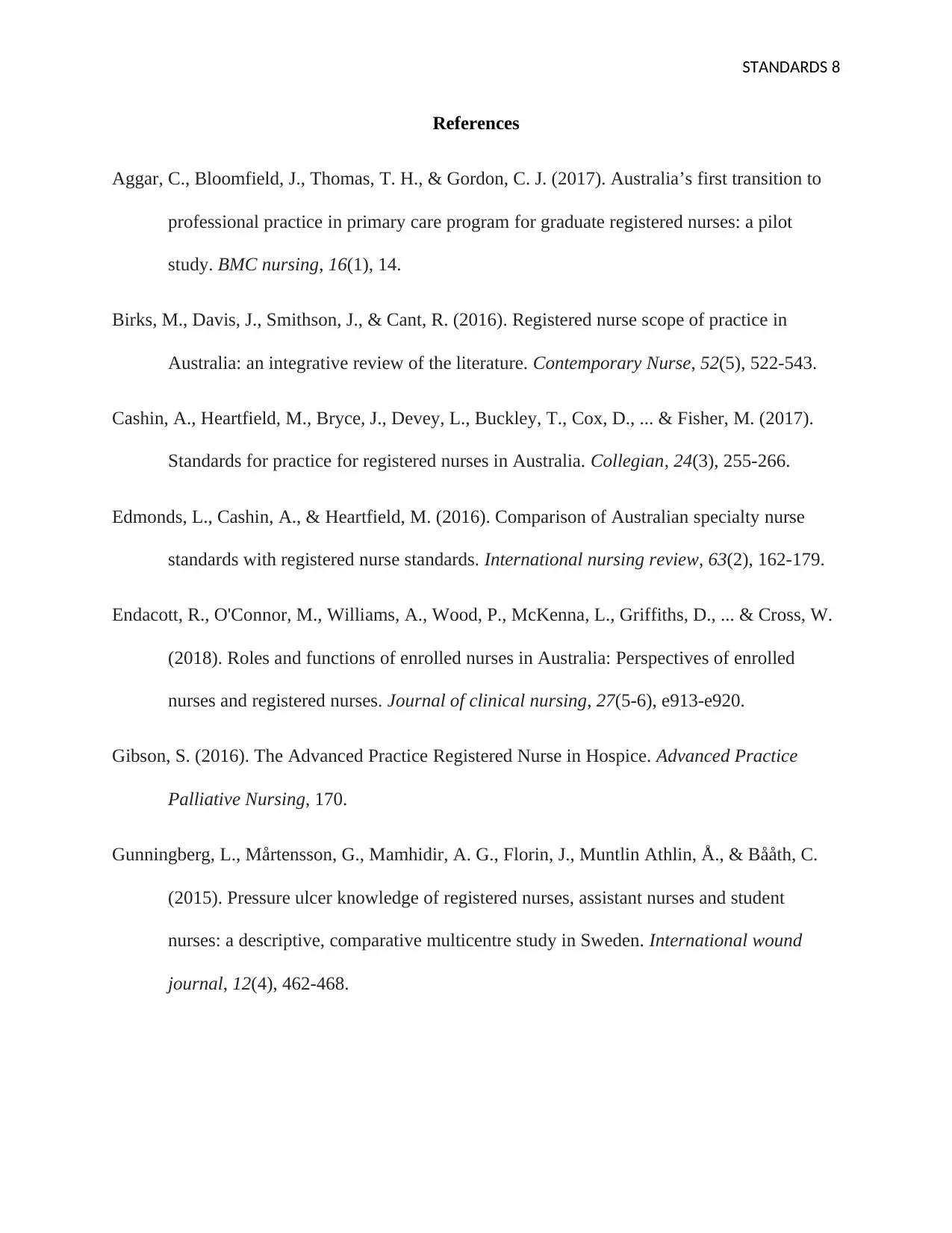
STANDARDS 8
References
Aggar, C., Bloomfield, J., Thomas, T. H., & Gordon, C. J. (2017). Australia’s first transition to
professional practice in primary care program for graduate registered nurses: a pilot
study. BMC nursing, 16(1), 14.
Birks, M., Davis, J., Smithson, J., & Cant, R. (2016). Registered nurse scope of practice in
Australia: an integrative review of the literature. Contemporary Nurse, 52(5), 522-543.
Cashin, A., Heartfield, M., Bryce, J., Devey, L., Buckley, T., Cox, D., ... & Fisher, M. (2017).
Standards for practice for registered nurses in Australia. Collegian, 24(3), 255-266.
Edmonds, L., Cashin, A., & Heartfield, M. (2016). Comparison of Australian specialty nurse
standards with registered nurse standards. International nursing review, 63(2), 162-179.
Endacott, R., O'Connor, M., Williams, A., Wood, P., McKenna, L., Griffiths, D., ... & Cross, W.
(2018). Roles and functions of enrolled nurses in Australia: Perspectives of enrolled
nurses and registered nurses. Journal of clinical nursing, 27(5-6), e913-e920.
Gibson, S. (2016). The Advanced Practice Registered Nurse in Hospice. Advanced Practice
Palliative Nursing, 170.
Gunningberg, L., Mårtensson, G., Mamhidir, A. G., Florin, J., Muntlin Athlin, Å., & Bååth, C.
(2015). Pressure ulcer knowledge of registered nurses, assistant nurses and student
nurses: a descriptive, comparative multicentre study in Sweden. International wound
journal, 12(4), 462-468.
References
Aggar, C., Bloomfield, J., Thomas, T. H., & Gordon, C. J. (2017). Australia’s first transition to
professional practice in primary care program for graduate registered nurses: a pilot
study. BMC nursing, 16(1), 14.
Birks, M., Davis, J., Smithson, J., & Cant, R. (2016). Registered nurse scope of practice in
Australia: an integrative review of the literature. Contemporary Nurse, 52(5), 522-543.
Cashin, A., Heartfield, M., Bryce, J., Devey, L., Buckley, T., Cox, D., ... & Fisher, M. (2017).
Standards for practice for registered nurses in Australia. Collegian, 24(3), 255-266.
Edmonds, L., Cashin, A., & Heartfield, M. (2016). Comparison of Australian specialty nurse
standards with registered nurse standards. International nursing review, 63(2), 162-179.
Endacott, R., O'Connor, M., Williams, A., Wood, P., McKenna, L., Griffiths, D., ... & Cross, W.
(2018). Roles and functions of enrolled nurses in Australia: Perspectives of enrolled
nurses and registered nurses. Journal of clinical nursing, 27(5-6), e913-e920.
Gibson, S. (2016). The Advanced Practice Registered Nurse in Hospice. Advanced Practice
Palliative Nursing, 170.
Gunningberg, L., Mårtensson, G., Mamhidir, A. G., Florin, J., Muntlin Athlin, Å., & Bååth, C.
(2015). Pressure ulcer knowledge of registered nurses, assistant nurses and student
nurses: a descriptive, comparative multicentre study in Sweden. International wound
journal, 12(4), 462-468.
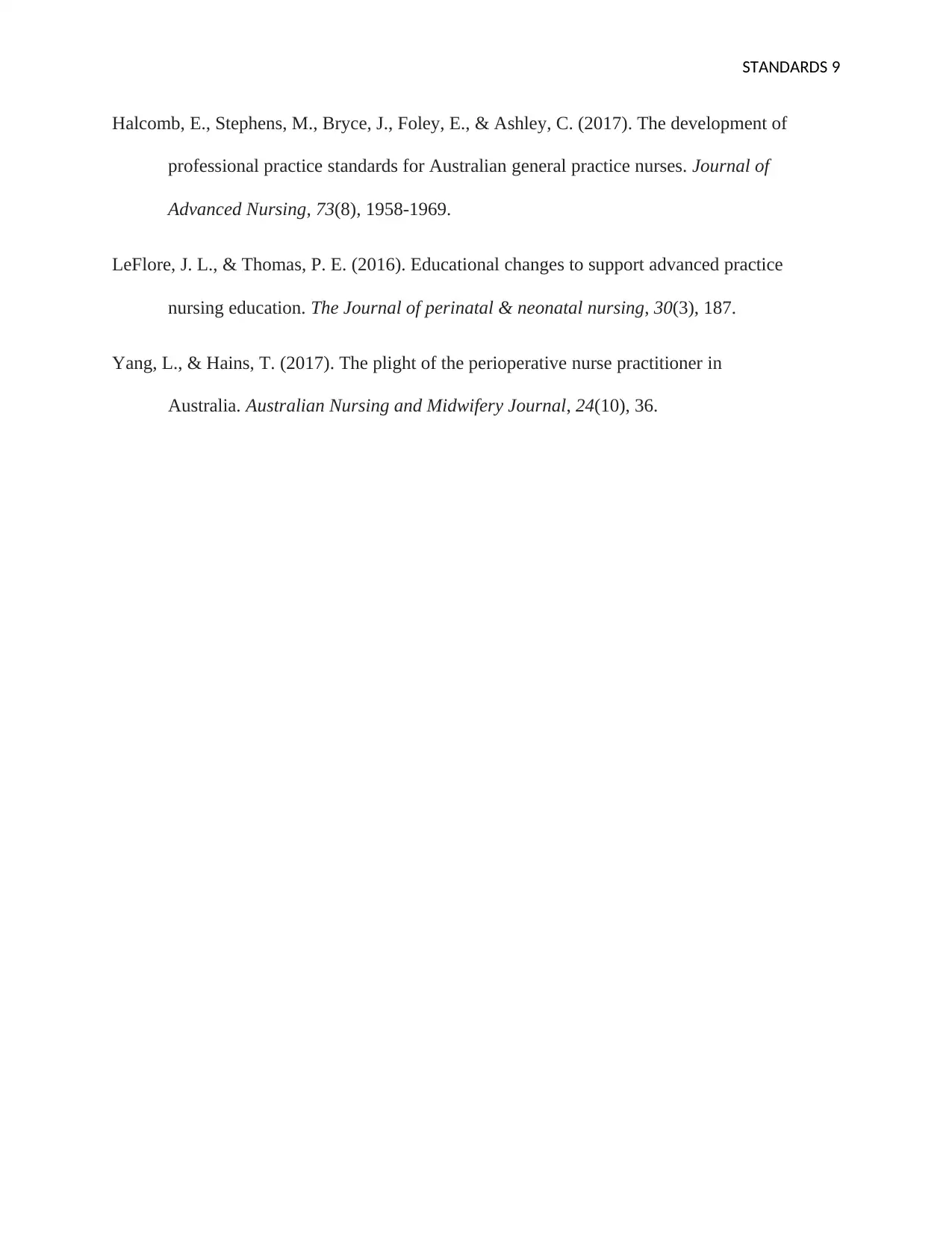
STANDARDS 9
Halcomb, E., Stephens, M., Bryce, J., Foley, E., & Ashley, C. (2017). The development of
professional practice standards for Australian general practice nurses. Journal of
Advanced Nursing, 73(8), 1958-1969.
LeFlore, J. L., & Thomas, P. E. (2016). Educational changes to support advanced practice
nursing education. The Journal of perinatal & neonatal nursing, 30(3), 187.
Yang, L., & Hains, T. (2017). The plight of the perioperative nurse practitioner in
Australia. Australian Nursing and Midwifery Journal, 24(10), 36.
Halcomb, E., Stephens, M., Bryce, J., Foley, E., & Ashley, C. (2017). The development of
professional practice standards for Australian general practice nurses. Journal of
Advanced Nursing, 73(8), 1958-1969.
LeFlore, J. L., & Thomas, P. E. (2016). Educational changes to support advanced practice
nursing education. The Journal of perinatal & neonatal nursing, 30(3), 187.
Yang, L., & Hains, T. (2017). The plight of the perioperative nurse practitioner in
Australia. Australian Nursing and Midwifery Journal, 24(10), 36.
⊘ This is a preview!⊘
Do you want full access?
Subscribe today to unlock all pages.

Trusted by 1+ million students worldwide
1 out of 9
Related Documents
Your All-in-One AI-Powered Toolkit for Academic Success.
+13062052269
info@desklib.com
Available 24*7 on WhatsApp / Email
![[object Object]](/_next/static/media/star-bottom.7253800d.svg)
Unlock your academic potential
Copyright © 2020–2025 A2Z Services. All Rights Reserved. Developed and managed by ZUCOL.




